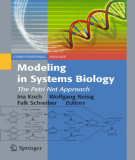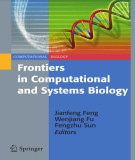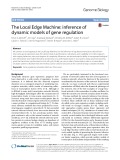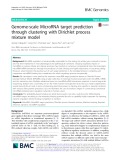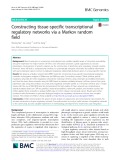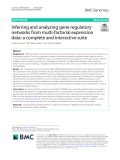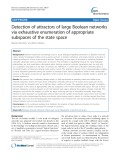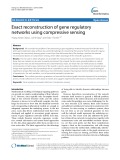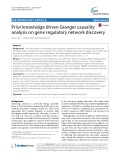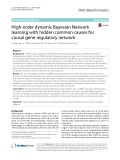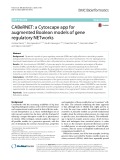
Gene regulatory network models
-
Ebook "Modeling in systems biology: The petri net approach" aims to meet a challenge that previously has been largely avoided by the Petri net community. The community used to be content with the demonstration that Petri nets were able to simulate quite a large number of partial systems when their homogeneity permitted a rather restricted application of the Petri net methodology. The proof of principle used to say that Petri net models can simulate otherwise established theoretical descriptions.
 378p
378p  ladongphongthanh1008
ladongphongthanh1008
 22-04-2024
22-04-2024
 4
4
 2
2
 Download
Download
-
Ebook "Frontiers in computational and systems biology" consists of 19 chapters and covers a wide spectrum of topics. Described applications of an RNA structure sampling algorithm to the rational design of short interfering RNAs for gene silencing by RNA interference and to target identification for microRNAs that play important roles in posttranscriptional gene regulation.
 411p
411p  ladongphongthanh1008
ladongphongthanh1008
 22-04-2024
22-04-2024
 5
5
 2
2
 Download
Download
-
Ebook "Systems biology: Functional strategies of living organisms (Second edition)" is an excellent introduction to systems biology, which has developed rapidly in recent years. It discusses the processes in living organisms in an integrated way, enabling the reader to understand the fundamental principles and cause-effect relationships in biology and biochemistry.
 269p
269p  manmanthanhla0201
manmanthanhla0201
 26-02-2024
26-02-2024
 6
6
 1
1
 Download
Download
-
Elucidation of regulatory networks, including identification of regulatory mechanisms specific to a given biological context, is a key aim in systems biology. This has motivated the move from co-expression to differential co-expression analysis and numerous methods have been developed subsequently to address this task; however, evaluation of methods and interpretation of the resulting networks has been hindered by the lack of known context-specific regulatory interactions.
 21p
21p  vielonmusk
vielonmusk
 30-01-2022
30-01-2022
 9
9
 0
0
 Download
Download
-
We present a novel approach, the Local Edge Machine, for the inference of regulatory interactions directly from time-series gene expression data. We demonstrate its performance, robustness, and scalability on in silico datasets with varying behaviors, sizes, and degrees of complexity. Moreover, we demonstrate its ability to incorporate biological prior information and make informative predictions on a well-characterized in vivo system using data from budding yeast that have been synchronized in the cell cycle.
 13p
13p  viaristotle
viaristotle
 29-01-2022
29-01-2022
 9
9
 0
0
 Download
Download
-
The developmental gene regulatory network (GRN) that underlies skeletogenesis in sea urchins and other echinoderms is a paradigm of GRN structure, function, and evolution. This transcriptional network is deployed selectively in skeleton-forming primary mesenchyme cells (PMCs) of the early embryo. To advance our understanding of this model developmental GRN, we used genome-wide chromatin accessibility profiling to identify and characterize PMC cis-regulatory modules (CRMs).
 18p
18p  vibeauty
vibeauty
 23-10-2021
23-10-2021
 12
12
 0
0
 Download
Download
-
MicroRNA regulation is fundamentally responsible for fine-tuning the whole gene network in human and has been implicated in most physiological and pathological conditions. Studying regulatory impact of microRNA on various cellular and disease processes has resulted in numerous computational tools that investigate microRNA-mRNA interactions through the prediction of static binding site highly dependent on sequence pairing.
 11p
11p  vitzuyu2711
vitzuyu2711
 29-09-2021
29-09-2021
 14
14
 1
1
 Download
Download
-
Recent advances in sequencing technologies have enabled parallel assays of chromatin accessibility and gene expression for major human cell lines. Such innovation provides a great opportunity to decode phenotypic consequences of genetic variation via the construction of predictive gene regulatory network models.
 13p
13p  viseulgi2711
viseulgi2711
 31-08-2021
31-08-2021
 7
7
 1
1
 Download
Download
-
Structural homology modeling supported by bioinformatics analysis plays a key role in uncovering new molecular interactions within gene regulatory networks. Here, we have applied this powerful approach to analyze the molecular interactions orchestrating death receptor signaling networks.
 12p
12p  visilicon2711
visilicon2711
 20-08-2021
20-08-2021
 16
16
 1
1
 Download
Download
-
Single-cell gene expression measurements offer opportunities in deriving mechanistic understanding of complex diseases, including cancer. However, due to the complex regulatory machinery of the cell, gene regulatory network (GRN) model inference based on such data still manifests significant uncertainty.
 11p
11p  visilicon2711
visilicon2711
 20-08-2021
20-08-2021
 6
6
 1
1
 Download
Download
-
High-throughput transcriptomic datasets are often examined to discover new actors and regulators of a biological response. To this end, graphical interfaces have been developed and allow a broad range of users to conduct standard analyses from RNA-seq data, even with little programming experience.
 15p
15p  vilichoo2711
vilichoo2711
 23-06-2021
23-06-2021
 10
10
 1
1
 Download
Download
-
Parameter estimation in biological models is a common yet challenging problem. In this work we explore the problem for gene regulatory networks modeled by differential equations with unknown parameters, such as decay rates, reaction rates, Michaelis-Menten constants, and Hill coefficients. We explore the question to what extent parameters can be efficiently estimated by appropriate experimental selection.
 12p
12p  viwyoming2711
viwyoming2711
 16-12-2020
16-12-2020
 8
8
 1
1
 Download
Download
-
In any gene regulatory network (GRN), the complex interactions occurring amongst transcription factors and target genes can be either instantaneous or time-delayed. However, many existing modeling approaches currently applied for inferring GRNs are unable to represent both these interactions simultaneously.
 22p
22p  viwyoming2711
viwyoming2711
 16-12-2020
16-12-2020
 14
14
 1
1
 Download
Download
-
Boolean models are increasingly used to study biological signaling networks. In a Boolean network, nodes represent biological entities such as genes, proteins or protein complexes, and edges indicate activating or inhibiting influences of one node towards another.
 10p
10p  viwyoming2711
viwyoming2711
 16-12-2020
16-12-2020
 13
13
 1
1
 Download
Download
-
We consider the problem of reconstructing a gene regulatory network structure from limited time series gene expression data, without any a priori knowledge of connectivity. We assume that the network is sparse, meaning the connectivity among genes is much less than full connectivity.
 22p
22p  vikentucky2711
vikentucky2711
 26-11-2020
26-11-2020
 16
16
 0
0
 Download
Download
-
Our study focuses on discovering gene regulatory networks from time series gene expression data using the Granger causality (GC) model. However, the number of available time points (T) usually is much smaller than the number of target genes (n) in biological datasets.
 18p
18p  vikentucky2711
vikentucky2711
 24-11-2020
24-11-2020
 12
12
 2
2
 Download
Download
-
We recently identified two robust ovarian cancer subtypes, defined by the expression of genes involved in angiogenesis, with significant differences in clinical outcome. To identify potential regulatory mechanisms that distinguish the subtypes we applied PANDA, a method that uses an integrative approach to model information flow in gene regulatory networks.
 17p
17p  vikentucky2711
vikentucky2711
 24-11-2020
24-11-2020
 19
19
 1
1
 Download
Download
-
Inferring gene regulatory network (GRN) has been an important topic in Bioinformatics. Many computational methods infer the GRN from high-throughput expression data. Due to the presence of time delays in the regulatory relationships, High-Order Dynamic Bayesian Network (HO-DBN) is a good model of GRN.
 28p
28p  vioklahoma2711
vioklahoma2711
 19-11-2020
19-11-2020
 13
13
 2
2
 Download
Download
-
Dynamical models of gene regulatory networks (GRNs) are highly effective in describing complex biological phenomena and processes, such as cell differentiation and cancer development. Yet, the topological and functional characterization of real GRNs is often still partial and an exhaustive picture of their functioning is missing.
 12p
12p  vioklahoma2711
vioklahoma2711
 19-11-2020
19-11-2020
 18
18
 2
2
 Download
Download
-
Over the last decade sensitivity analysis techniques have been shown to be very useful to analyse complex and high dimensional Systems Biology models. However, many of the currently available toolboxes have either used parameter sampling, been focused on a restricted set of model observables of interest, studied optimisation of a objective function, or have not dealt with multiple simultaneous model parameter changes where the changes can be permanent or temporary.
 19p
19p  vioklahoma2711
vioklahoma2711
 19-11-2020
19-11-2020
 26
26
 1
1
 Download
Download
CHỦ ĐỀ BẠN MUỐN TÌM








